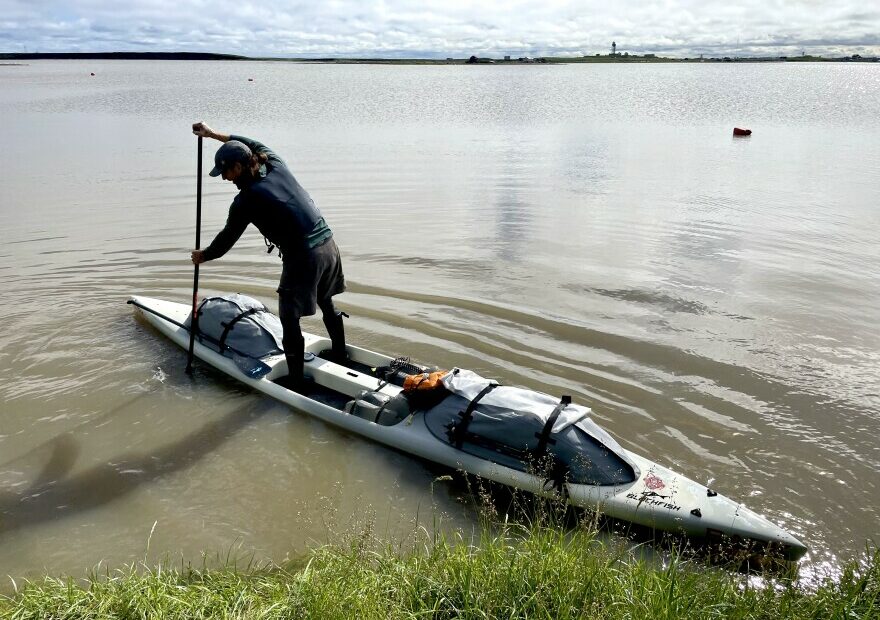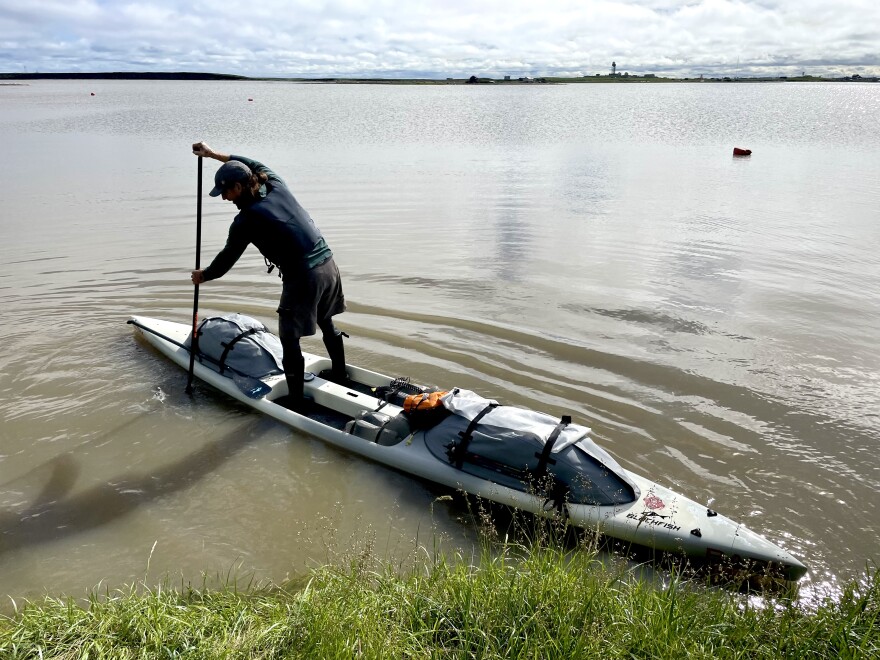
Beware Of Polar Bears! Washington Adventurer Aims To Be 1st Through Northwest Passage On Paddleboard
Listen
(Runtime 4:38)
Read
An adventurer from Western Washington cast off this week trying to become the first person to traverse the Northwest Passage on a standup paddleboard. The passage is the fabled, but normally frozen, sea route between the Atlantic and the Pacific across the far north of Canada.
The solo paddleboard journey is the brainchild of Karl Kruger of Orcas Island, Washington. If that name sounds at all familiar, it might be because Kruger is the first — and so far only — person to complete the 750-mile Race to Alaska from Port Townsend to Ketchikan on a standup paddleboard. It was during that 2017 race up the Inside Passage — the R2AK in shorthand — that Kruger said he had the idea to take on the much longer Northwest Passage for a “deeper experience.”
“What I found myself wanting after R2AK was more, simply put,” Kruger explained. “What made me happiest about the Race to Alaska was a), the solitude and b), the connections that I made along the way with people.”
On Sunday, Kruger launched his 18-foot, custom-built expedition-style paddleboard into the Arctic Ocean from Tuktoyaktuk, near the northwest corner of Canada. The attraction of that launch point is that it is the only place along the Northwest Territories’ Arctic coastline connected by road to the rest of North America. If all goes according to plan, Kruger will hug the coastline going eastward and follow the receding pack ice for 1,900 miles until he gets to Pond Inlet on the northeastern tip of Baffin Island, Canada.
“There are so many risks I can’t even count them all, physical risks to doing this project,” Kruger said. “But at the same time I also know I’m capable of it. At the end of it, I’ll have a lot to share. For me personally, I think the greatest danger of this trip is failing to do it.”
The risks include stormy weather, hungry polar bears, shifting sea ice and hypothermia from falling into the cold, cold water. Race to Alaska co-founder Jake Beattie said he is not too worried about Kruger’s survival on this voyage.
“When I first heard about his paddle of the Northwest Passage, I think I had two reactions. They were simultaneously, no flippin’ way and if anyone can do it, Karl can do it,” Beattie said from Port Townsend.
Beattie described Kruger as “an incredibly competent mariner” with an “amazing combination” of physical fitness and mental toughness.
“He’s like no one I have ever met,” Beattie said. “He can make it through anything.”
Kruger organized resupply drops in coastal villages along the planned route. He paddles between them with bundles of freeze-dried food and high-energy protein shake mix lashed to the bow and stern of his paddleboard.
Perhaps the most unusual gear Kruger packed for this odyssey is a trip wire to encircle his tent. That wire sets off a loud bang if a polar bear approaches while Kruger is sleeping.
The 50-year-old father is giving himself about seven weeks to complete the Northwest Passage before returning to his day job as a guide and charter boat captain based in Washington’s San Juan Islands. Support crew member Elyn Oliver wrote in a Facebook update Monday night that Kruger covered 14 miles on his departure day and achieved 15 miles on day two as he battled strong headwinds and choppy seas.
In an email interview from Tuktoyaktuk on the eve of departure, Kruger said he expected highlights of the journey to include paddling alongside beluga whales, seeing his first polar bear in the wild, threading ice floes and meeting Inuit residents and learning about their connection to the warming North. He said one of his motivations besides personal challenge and fulfillment was to draw attention to how Inuit lifeways and the Arctic environment are changing.
“What also drew me to this project is the very reason that it is possible for me to paddle through here in a single season: climate change,” Kruger said. “The Arctic is not what people imagine it is any longer. It has changed quite a lot.”
The Northwest Passage has drawn the interest of explorers for centuries. Some of the most accomplished seafarers in history took fruitless stabs at finding a shorter trade route from Europe to the Far East, including John Cabot, Captain James Cook, George Vancouver and Vitus Bering. The Arctic route was hard to figure out because of shoals and the nearly year-round presence of sea ice.
Norwegian explorer Roald Amundsen led the first expedition to successfully sail all the way through, and that wasn’t completed until 1906. It took another 38 years before the second navigation happened, this by a Royal Canadian Mounted Police crew in a schooner reinforced to handle icy waters.
The recent seasonal retreat of the pack ice due to climate change has brought an increase in marine traffic and commercial interest in the high Arctic, which in turn led the Canadian Coast Guard to create an Arctic Region command in 2018. But search and rescue assets are still few and far between.
“Traversing the Northwest Passage is a risky undertaking, and that’s in favorable weather conditions. Oftentimes the weather conditions are unfavorable and it’s a challenge for even a larger, well-equipped vessel,” said the Canadian Coast Guard’s Steve Thompson, the superintendent for maritime search and rescue in the Arctic Region.
“The Arctic is unforgiving. These trips are dangerous and those undertaking them really need to consider the risks they pose to themselves as well as to others, including the community responders as well as professional responders.”
If an adventurer were to run into trouble, the first people to come to the rescue would probably be Inuit villagers or hunters. Thompson said the Canadian Coast Guard had provided training, and in some cases new rescue boats, to volunteers in Arctic villages who serve as Coast Guard auxiliary.
Kruger is carrying a SPOT satellite tracker, a device which can transmit a distress signal and serve as an emergency locator beacon. The tracker device updates his location around the clock on a public online map.
Two other expeditions made plans for historic first transits of the Northwest Passage under human power this summer, albeit in the opposite direction Kruger chose. Scotsman Levan Brown was planning to depart Baffin Island with two eight-person rowboats bound for Point Barrow, Alaska, but announced in June that the expedition would be postponed until next summer due to unfavorable ice conditions and supply line issues.
Any day now, a Texas trio dubbed the Arctic Cowboys expects to depart Pond Inlet for Tuktoyaktuk in sea kayaks. Like Kruger, the Cowboys plan to camp on shore, but since there are three of them, they can sleep in shifts with one person keeping a lookout for polar bears under the midnight sun. They’re giving themselves two months to traverse the Northwest Passage westbound.
















